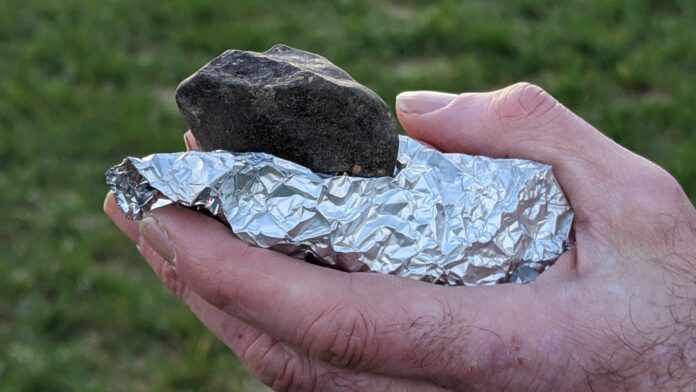A piece of the meteoroid that astronomers predicted would hit Earth on Sunday night has amazingly been recovered in Normandy, France.
The news(Opens in a new window) comes from an organization called Vigie Ciel in France, which is devoted to tracking meteorites, or space rocks that have fallen to Earth. The group assembled a team of amateur and professional astronomers to try and find Sunday’s meteoroid after it was spotted burning across the skies over Northern France.
According to Vigie Ciel, an 18-year-old art school student named Loïs Leblanc spotted a “dark stone” in a field outside the French town of Saint-Pierre-le-Viger. The team then analyzed the object and confirmed it was a fragment from Sunday’s meteoroid.
The meteoroid — originally dubbed SAR 2667, but now called 2023 CX1— was estimated to be about one meter in size before it impacted Earth’s atmosphere. The space rock was also projected to arrive around northern France, which gave the public a chance to spot and record 2023 CX1 as it burned across the sky.
Using astronomical observations and video from the public on the ground, Vigie Ciel was able to calculate(Opens in a new window) where 2023 CX1 might have landed in northern France. The group also predicted fragments of the space rock would’ve survived given its mass and speed when entering Earth’s atmosphere.
Vigie Ciel didn’t immediately respond to a request for comment. But meteorites can be identified by looking at several traits(Opens in a new window) including whether they have a “fusion crust” or dark burn marks from atmospheric entry. They’re also usually rich in iron, making them instantly attracted to magnets.
What will happen to the recovered fragment remains unclear. However, Vigie Ciel plans on organizing additional teams to find other pieces of 2023 CX1 that may have also landed in France.
Recommended by Our Editors
2023 CX1 represents the seventh time astronomers have detected an asteroid or meteoroid in space before impact. “The last three predicted impacts have all occurred in the last 12 months —an encouraging illustration of how asteroid detection capabilities are rapidly advancing,” the European Space Agency said(Opens in a new window).
Fortunately, 2023 CX1 was too small to cause any destruction. However, astronomers remain on the lookout for far larger asteroids that could cause massive devastation if they were ever to slam into our planet. In response, both NASA and the European Space Agency have been working on projects designed to knock an incoming asteroid out of harm’s way.
Get Our Best Stories!
Sign up for What’s New Now to get our top stories delivered to your inbox every morning.
This newsletter may contain advertising, deals, or affiliate links. Subscribing to a newsletter indicates your consent to our Terms of Use and Privacy Policy. You may unsubscribe from the newsletters at any time.
Hits: 0














